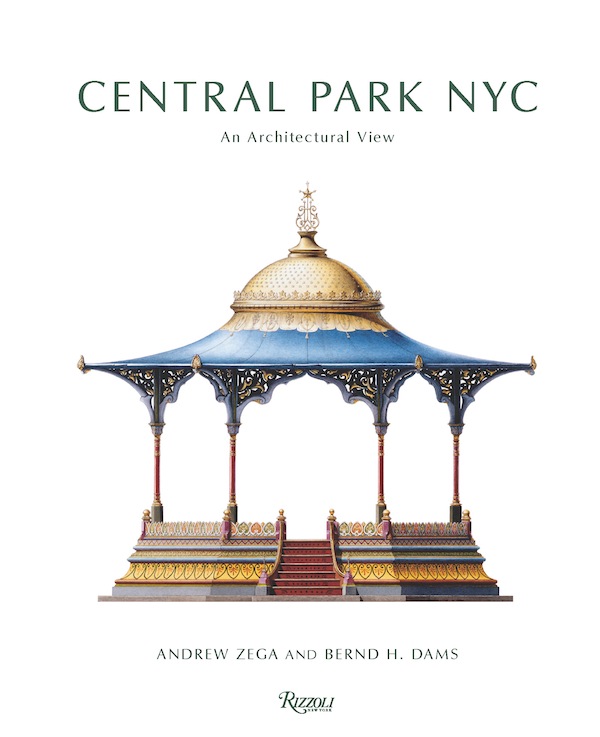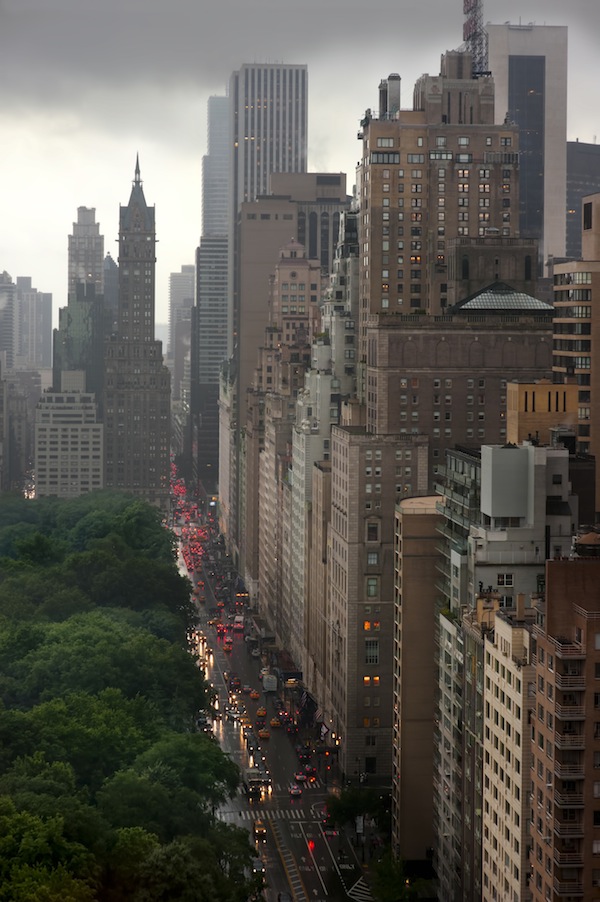Ever since the 2008 publication of their superb volume on Chinoiseries, many have been eagerly awaiting the next publication from Andrew Zega and Bernd H. Dams. Happily, Central Park NYC: An Architectural View is finally here. Following years of exacting research, this lavish and unprecedented volume traces the history, creation and beauty of this National Historic Landmark from their very visual point of view.
As architects, voracious historians, skilled writers and talented artists, the authors possess the unique skill sets to deliver projects of delightful discovery and extravagant beauty. Celebrating the “fortuitous intersection of architecture and gardens,” this volume, through the author’s exquisite watercolors accompanied by contemporary and archival photographs, explores the rich diversity and design of Central Park and its architecture, sculpture and ornament. The realistic rendering and historical accuracy of Zega’s and Dam’s artwork brings back to life many of the park’s features that have been altered, demolished or never realized. One such structure is featured on the book’s jacket, above. Affectionately known as “the Old Bandstand,” the marvelously decorative Music Pavilion was sadly destroyed in 1922 as were the “elaborate cages for birds of rich plumage” which sat on the concert ground now occupied by the Naumburg Bandshell.
Each of the thirteen chapters in the book examines a different feature or design element of the park, all set within the historical context. Beginning with a broad overview, the reader learns just how revolutionary a project Central Park was in the mid 19th century. Even Trollope, visiting in 1862, pronounced, “You must swear by cock and pie that it is more fine, more grand, more beautiful, more miraculous than anything else of the kind anywhere.” And today as you look east across Central Park South (below), you can see how effective Olmsted and Vaux’s plan was to densely plant the park’s borders to protect it from the urban bustle of the city.
 photo by Joseph O. Holmes
photo by Joseph O. Holmes
Period photographs illustrate the park’s popularity. While intended for the enjoyment of all, Central Park was the perfect setting for the wealthy to display the splendor of their carriages and attire. Footpaths assured that “pedestrians may have ample opportunity to look at the equipages and their inmates.”
An anchoring feature of the park’s design was Belvedere Castle, a folly that still stands on Vista Rock, a large immovable element that became the focus around which the lower half of the park was organized. Intended to draw people to its tower for uninhibited views of the entire park, its height was appealing to the National Weather Service who, starting in 1919, used it for taking scientific measurements. But after moving equipment elsewhere in the 1960s, it became abandoned and a victim of vandals. Rescued by the Central Park Conservancy in 1983, it was renovated and now serves at the Henry Luce Nature Observatory and host to various family and community programs. Below, the authors’ watercolor illustrates the original design including a villa that was never completed.
I love the title of chapter IX, A Sculptural Bestiary. It references the delightful initiative by Robert Moses, under his autocratic reign as Parks Commissioner, to add more child friendly sculpture to Central Park. Replacing the antiquated Victorian art from the park’s grounds, his administration commissioned many works including the well loved Honey Bear Fountain by Brooklyn native Frederick G. R. Roth, installed at the Central Park Zoo in 1937 and eloquently captured in the authors’ watercolor below.
 This is a wonderful volume for anyone interested in history, the decorative arts, architecture, urban planning or the cultural heritage of NYC. Even for those who live in New York and walk the park’s paths daily, you will find new (and old) visual treats and surprises that help illuminate the parks’s glorious past, present and perhaps future. And one feature to note is that in actuality the authors’ watercolors range in size from small detailed studies to works of architectural and sculptural elements dramatically executed at life size. For those in or traveling to NYC this fall, there will be a show of the watercolors from the book held at Didier Aaron from October 24 to November 8, with 10% of all proceeds from sales to the Central Park Conservancy.
This is a wonderful volume for anyone interested in history, the decorative arts, architecture, urban planning or the cultural heritage of NYC. Even for those who live in New York and walk the park’s paths daily, you will find new (and old) visual treats and surprises that help illuminate the parks’s glorious past, present and perhaps future. And one feature to note is that in actuality the authors’ watercolors range in size from small detailed studies to works of architectural and sculptural elements dramatically executed at life size. For those in or traveling to NYC this fall, there will be a show of the watercolors from the book held at Didier Aaron from October 24 to November 8, with 10% of all proceeds from sales to the Central Park Conservancy.











What a treasure of a book! Central Park is such a special place and this book captures its magic. I know just the person who will be getting this as a Christmas gift. And of course I’ll be getting myself a copy while I’m at it!
Beautiful renditions!! franki
The Central Park Conservancy was near and ear to us when we lived in the city and we never missed an opportunity to donate to this historic landmark. This looks like the perfect gift for any and all New Yorkers!
xxoo
C + C
What a beautiful book and wonderful memories for me. We moved to New York when our daughter was 5 weeks old and Central Park was her playground for 3 years. Can hardly wait to get a copy of this amazing book.
Can’t wait to peruse this book…. Central Park is a gift to every human who experiences it. Thanks for pointing, Quintesence! And much continuing success!
The Belvedere Castle will be renovated this fall. I read that a “wooden tower” that stood on the northwest corner will be recreated. I have searched on line for a picture of this structure but I cannot find one. I was hoping you might be able to provide one. What did this tower look like?